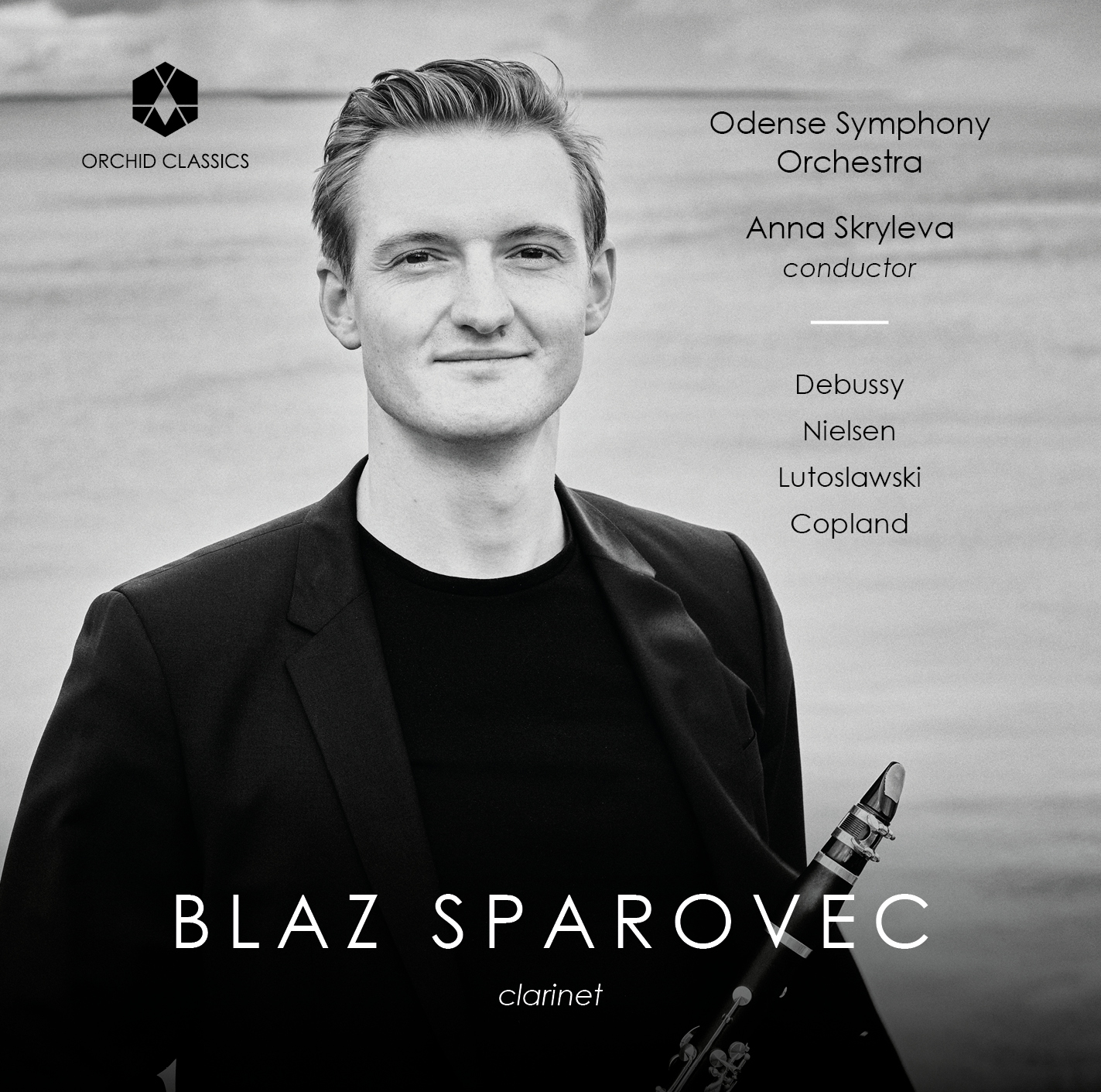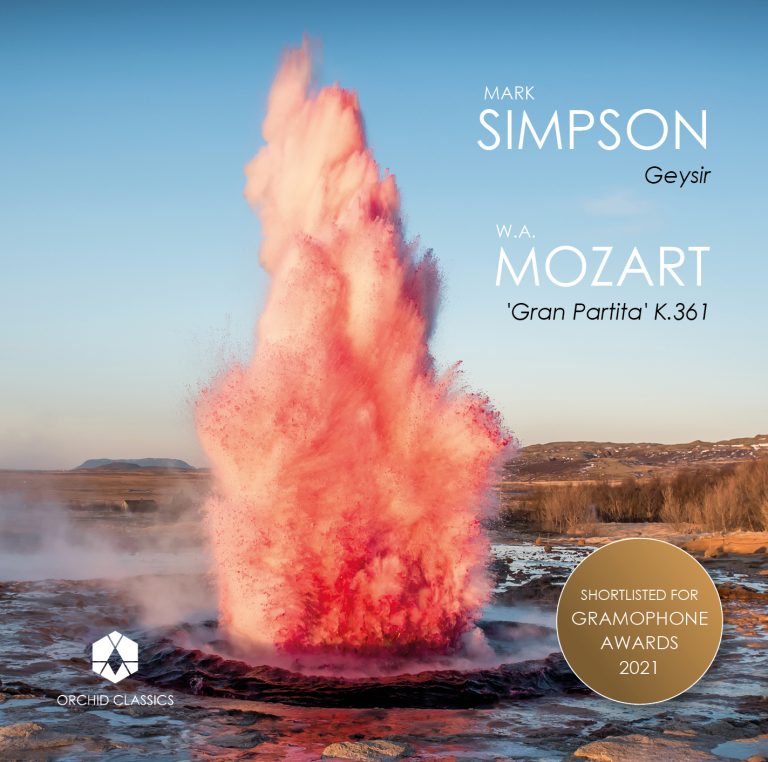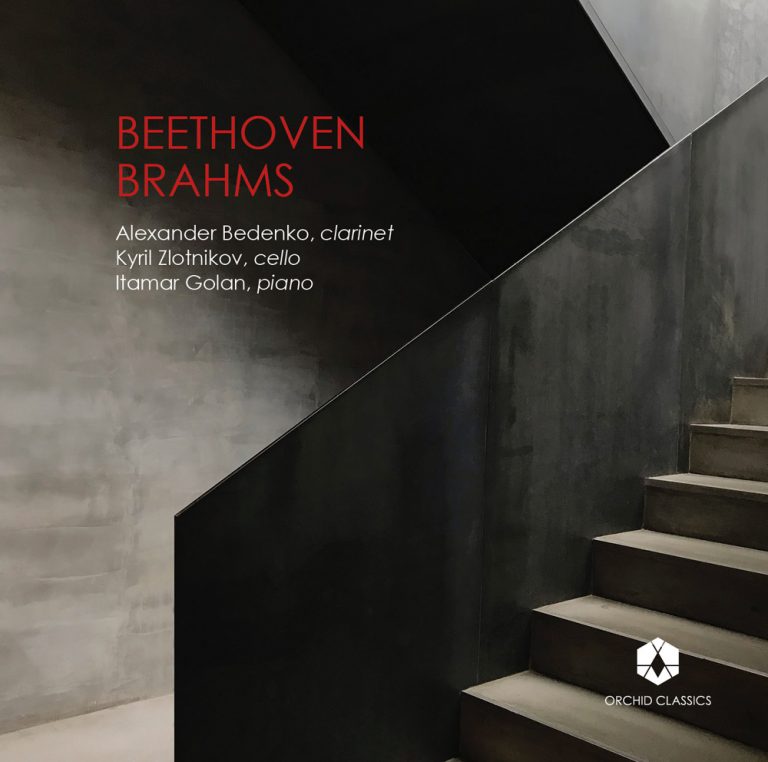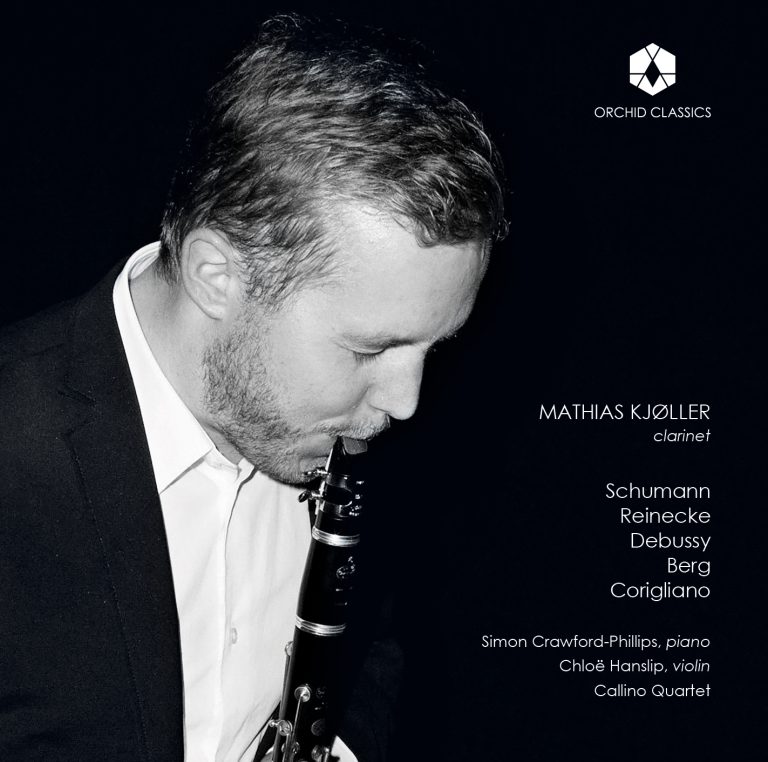Artist Led, Creatively Driven

Blaz Sparovec, clarinet
Debussy, Nielsen, Lutoslawski, Copland
Odense Symphony Orchestra
Anna Skryleva, conductor
Vincenzo Milletarì, conductor (Debussy)
Release Date: July 9th
ORC100168
Claude Debussy (1862-1918)
1. Première Rhapsodie* (Orchestral version)
Live recording
Carl Nielsen (1865-1931)
Concerto for clarinet and orchestra, Op.57
2. I Allegretto un poco
3. II Poco Adagio
4. III Allegro non troppo
5. IV Allegro vivace
Witold Lutosławski (1913-1994)
Dance Preludes for Clarinet Solo, Percussion, Harp,
Piano and Strings
6. I Allegro molto
7. II Andantino
8. III Allegro giocoso
9. IV Andante
10. V Allegro molto
Aaron Copland (1900-1990)
Concerto for Clarinet and String Orchestra, with Harp and Piano
11. I Slowly and expressively
12. II Cadenza (freely)
13. III Rather fast
Total time 61.22
Blaz Sparovec, clarinet
Odense Symphony Orchestra
Anna Skryleva, conductor
Vincenzo Milletarì*, conductor
Claude Debussy never sought a teaching post, but he maintained a relationship with the Paris Conservatoire for much of his career and, in 1909, was appointed to its Board of Directors (le Conseil Supérieur) by Gabriel Fauré. The newspapers responded wryly at the hitherto rebellious composer becoming part of the establishment, but Debussy did not much care. He was quite ill by this time, his doctors initially prescribing a heady mix of exercise, morphine, and cocaine.
One of Debussy’s duties in his Conservatoire role was to write two pieces for the clarinet competitions to be held the following year, for which he also sat on the jury. He completed one, the Première rhapsodie, but never finished a second. (His Rhapsodie pour orchestra et saxophone, begun in 1903, was later realised by Jean Roger-Ducasse.) The Première rhapsodie leaves the soloist with nowhere to hide, exploiting the clarinet’s most dangerous registers and fingerings and demanding exceptional breath control. All this while taking us on a whistle-stop tour of emotions and tempi: in under ten minutes, the work passes through about 20 different tempo markings.
The work starts in a mood of dreamy lyricism before unfurling playful chromatic ideas reminiscent of Debussy’s piano piece, Poissons d’or from his second volume of Images (1907), concluding with a jazzy gesture of bravado. Debussy originally scored the Rhapsodie for clarinet and piano before arranging it for clarinet and orchestra in 1911. In 1908 he spoke of his approach to orchestration: “I try to use each timbre in its pure state; as Mozart does, for example… Strauss’s orchestra is nothing but a compound like an American drink, which mixes eighteen ingredients; all the individual tastes disappear. It’s a cocktail orchestra… Split up the woodwind. Mix the bassoons up with the cellos, the clarinets and oboes with the violins; so that their entries don’t sound like somebody dropping a parcel.”
Carl Nielsen also prized musical directness, although of a different kind often based on folk elements from his native Denmark. In his book Living Music he argued that: “The simplest is the hardest, the universal the most lasting, the straightest the strongest, like the pillars that support the dome.” Following years of personal crisis and professional duties that risked stifling his creativity, as well as sadness at the lack of international recognition for his music, Nielsen was rejuvenated by an encounter with the Copenhagen Wind Quintet in 1921. He heard them playing Mozart and promptly composed his Wind Quintet for the group, which he admired for its musicality and tone. Nielsen intended to write a concerto for each member of the quintet and ended up completing two: a Flute Concerto (1926) and the Clarinet Concerto (1928) for the ensemble’s clarinettist, Aage Oxenvad.
The Clarinet Concerto – regarded by many as the most significant of the 20th century – is characterised by conflict, with tonal tussles between the keys of F and E, often punctuated by snare drumrolls apparently reflecting Nielsen’s anxiety at the unsettled world in which he found himself. These stark juxtapositions may also have been composed with the soloist in mind; Oxenvad was bipolar, and the snare often interrupts the clarinet in its softer moments. Nielsen described the clarinet as: “at once warm hearted, and completely hysterical, gentle as balm and screaming as a streetcar on poorly lubricated rails”. Of the Concerto he wrote: “I actually have no idea how it will sound. Maybe it won’t sound good, but I will not compose music if I always have to compose in the same manner.”
The three sections of the Concerto flow seamlessly; the first includes an irascible clarinet cadenza, the second begins with a wistful horn solo, and the third is ushered in by another cadenza, with more prominent writing for the horn. There is a third cadenza and further flurries of activity before the work comes to rest in the exquisite string harmonics of the final bars.
Nielsen’s Concerto was first performed at a private concert in September 1928. His son-in-law, Emil Telmányi, was conducting and described it as “music from another planet”. Public performances followed, to mixed reactions: the critic Olaf Petersen-Berger, after the Swedish premiere, wrote that the work was “absolutely the worst thing that this slightly too obviously experimental and provocatively sidestepping Dane has yet put together”. The Politiken newspaper, on the other hand, argued that Nielsen “has liberated the soul of the clarinet, not only the wild animal aspect but also its special brand of ruthless poetry… This work could hardly have found a more homogeneous interpretation. Oxenvad’s sonority is in tune with the trolls and the giants, and he has soul, a rough and stocky primordial force mixed with naive Danish mildness. Certainly, Carl Nielsen must have had his particular clarinet sound in mind while composing this Concerto.”
If Nielsen was resentful of the cultural whims blocking his path to worldwide recognition, Witold Lutosławski was hampered even before his compositions saw the light of day, stymied by the tumultuous political events of his time. After the Second World War, when Lutosławski had been imprisoned by the German Wehrmacht but escaped to Warsaw, the Soviet Union established a Communist government in Poland. Artists who did not toe the party line and produce accessible, folkoristic music were censored; in 1948 Lutosławski was forced to leave the committee of the Polish Composers’ Union, and in the following year his First Symphony became the first major Polish composition to be banned for being too ‘formalist’. Lutosławski survived by composing palatable public pieces and folk-based concert works, but in private he explored more radical techniques. The Dance Preludes (1954) belong to the folk-based area of his output and remain one of his most popular works. Originally for clarinet and piano, Lutosławski made two orchestral arrangements in 1955 and 1959; we hear the earlier version, which retains much of the original clarinet line rather than passing it between the instruments. This arrangement was premiered at the Aldeburgh Festival, with Benjamin Britten conducting.
For the five Dance Preludes Lutosławski did not use recognisable Polish folk melodies, but rather evoked the general character of Polish music with changeable meters and a strong sense of rhythm. The vivacious, staccato opening movement veers between groupings of 2 and 3, whereas the second dance is more lyrical. The central movement is in the style of a scherzo, with further metrical shifts and shrill writing for the soloist that evokes the E-flat clarinet used in some Polish folk music. Pizzicato double bass and low piano gestures set the scene for the meditative clarinet melody of the fourth dance, and the work concludes with a rustic but metrically complex final movement, in which the clarinet is sometimes at odds with the rhythm of the orchestra.
Aaron Copland wrote some early songs in the style of Debussy, “who I thought was ‘hot stuff’ before Scriabin then Stravinsky took his place in my mind as the foremost modern composer.” By the time he started his Clarinet Concerto in 1947, Copland’s own distinctive voice had long since emerged. The work was commissioned by jazz clarinettist Benny Goodman, who later recalled: “I made no demands on what Copland should write. He had completely free rein … We never had much trouble except for a little fracas about the spot before the cadenza where he had written a repetition of some phrase. I was a little sticky about leaving it out… But I think Aaron finally did leave it out… Aaron and I played the concerto quite a few times with him conducting”.
Goodman also balked at some of the more demanding passages and soaring pitches of the original score, making several alterations. For this recording we hear the original version based on Copland’s score and sketches, without Goodman’s amendments. Copland had finished the work late in 1948 but Goodman kept putting off the work’s first public performance, which he eventually gave during a broadcast of 1950 conducted by Fritz Reiner. The piece was quickly popular, and was well received by Copland’s peers, too. “Stravinsky and I corresponded occasionally through the years; we sent birthday greetings and developed an informal way with each other. Once in a while, I sent him a score. About my Clarinet Concerto he wrote (14 August 1950): ‘I want to tell you how much I love your Clarinet Concerto and how glad I have been to receive it from you…’ Yet even after we began to address each other as ‘Cher ami’ I never completely lost that awe I felt for Igor Stravinsky from the time I was a young student in Paris.”
The Concerto consists of two outer movements sandwiching a central cadenza and draws heavily on jazz styles. After a slow, poignant opening movement, the cadenza introduces Latin American elements, which are further brought out in the jaunty, virtuosic final movement. As Copland explained: “The instrumentation being clarinet with strings, harp, and piano, I did not have a large battery of percussion to achieve jazzy effects, so I used slapping basses and whacking harp sounds to simulate them. The Clarinet Concerto ends with a fairly elaborate coda in C major that finishes off with a clarinet glissando – or ‘smear’ in jazz lingo.”
© Joanna Wyld, 2021
Slovenian born clarinetist, Blaz Sparovec, is one of the leading artists of his generation and first prize winner of the 2019 Carl Nielsen Competition. Alongside a growing reputation as a soloist, Blaz has been principal clarinetist of the Gürzenich-Orchestra Cologne since 2015 and is Associate Professor at the University of Arts in Berlin. He also performs as a guest principal with leading German orchestras, including the Staatskapelle Dresden and WDR Symphony Orchestra, and is a passionate chamber musician, partnering with artists such as Anna Lucia Richter, Bernarda Fink and Pierre-Laurent Aimard.
As a soloist, Blaz has appeared with the Gürzenich-Orchestra Cologne, Düsseldorf Symphony Orchestra, Odense Symphony Orchestra, Copenhagen Philharmonic, Slovenian National Philharmonic, RTV Slovenia Symphonic Orchestra and Göttingen Symphony Orchestra.
In 2015 Blaz released his debut album entitled “Enter Clarinet”, performing a wide span of repertoire from Debussy to Penderecki showing “a bold programme selection that presents the master student of François Benda as a versatile musician” (Das Orchester). Also reviewing the album, Germany’s Klassik-Heute commented “To put it bluntly: Blaz Sparovec succeeds brilliantly (…) thanks to the twenty-one-year-old’s ability to guide his instrument like the human voice (…) Sparovec’s articulation is crystal-clear, his phrasing highly vivid (…) creating the purest joy of playing and joie de vivre.
In 2020 he recorded his second album for the British label Orchid Classics, reuniting with the Odense Symphony Orchestra for the first time since winning the Carl Nielsen Competition. On that occasion Blaz was awarded not only first prize but also the Odense Symphony Orchestra Prize and Junior Jury Prize for his performance of the Nielsen Clarinet Concerto which was broadcast internationally on medici.tv.
Prior to his success at the Carl Nielsen Competition, Blaz has won numerous international prizes both in his native Slovenia and internationally, including the 1st prize and Audience Prize in the Aeolus Winds Competition 2014 and 1st prize in the hülsta woodwinds competition in the same year. In 2012 he represented Slovenia in the Eurovision Young Musicians Competition in Vienna, having previously won a special prize at the 2011 Concertino International Radio Competition in Prague.
Blaz grew up and studied in Slovenia with Andrej Zupan at the Ljubljana Conservatory of Music, before moving to Germany to continue his studies with François Benda at the University of Arts in Berlin under the patronage of the Republic of Slovenia.
Anna Skryleva has worked in some of Germany’s most distinguished opera houses and from the 2019/20 Season takes up the position of General Music Director at Theater Magdeburg.
From 2013-15, Anna was First Kapellmeister at the Staatstheater Darmstadt where she made her debut conducting Strauss’s Salome. She previously held the same position at the Staatstheater Schleswig-Holstein, where her interpretation of Weber’s Der Freischütz met with critical acclaim.
Anna has been employed on the music staff of both the Cologne Opera and the Staatsoper Hamburg. She worked as first assistant conductor for landmark productions of Wagner’s Der Ring des Nibelungen at both companies, where she collaborated closely with music directors Markus Stenz and Simone Young. In Hamburg, Anna conducted main-stage performances including Lehar’s The Merry Widow, Humperdinck’s Hänsel und Gretel and Rossini’s Il turco in Italia.
As a guest conductor, Anna has appeared at houses including the Dallas Opera and the Hessian State Theater, Wiesbaden. In the season 2019/2020 she makes her debut at The Royal Swedish Opera Stockholm with Mozart’s The Magic Flute and Tchaikovsky’s The Nutcracker.
Anna Skryleva is under great demand on the concert stage, working with the Frankfurt Radio Symphony Orchestra, the Aarhus Sinfonieorchester and Copenhagen Philharmonic, the South German Philharmonic Konstanz, the North German Philharmonic Rostock, the Orquesta Filarmónica de la UNAM in Mexico City and debuts with the Deutsches Sinfonie Orchester Berlin in March 2020.
She is an experienced ballet conductor and has worked with dance companies including New York’s Paul Taylor Dance Company.
Anna’s operatic repertoire ranges from the Viennese classics through to German and Russian Romantics, the Italian bel canto school, and staple works of the twentieth century and beyond. She has conducted works by composers from Wagner to Kurt Weill, from Rossini to John Adams.
Anna was named Person of the Year in 2013 by the arts section of the Main-Echo newspaper. In 2014, she founded the international peace initiative Classics for Peace, which immediately met with widespread support from both the public and from high-ranking politicians, including the Hessian State President Volker Bouffier.
Anna was raised in Moscow, where she studied piano and composition at the Moscow State Tchaikovsky Conservatory. She later studied at the University of Fine Arts in Berlin. She signed to Nordic Artists Management in 2018.
Vincenzo Milletarì, the young Italian conductor, is one of the most respected and sought-after conductors of his generation. After studying at the “Giuseppe Verdi” Conservatory in Milan and the Royal Danish Academy of Music in Copenhagen, he pursued advanced studies with Riccardo Muti at the Accademia dell’Opera Italiana in Ravenna and with Pier Giorgio Morandi.
He won second prize at the 10th “Arturo Toscanini” International Conducting Competition and the “Hera Comm” audience award in Parma. In 2015 he was awarded 2nd prize at the “Sir Georg Solti” competition in Chicago.
He embarked on his career in 2017, and soon was to be seen at the Royal Danish Opera, Royal Swedish Opera and Czech State Opera, the Festival della Valle d’Itria and the Macerata Opera Festival. He has conducted Milan’s Orchestra Sinfonica La Verdi, Parma’s Filarmonica Toscanini, Bologna’s Orchestra del Teatro Comunale and the Aalborg and Odense Symphony Orchestras.
Upcoming engagements include concerts at the Musikverein in Vienna, with the ORT – Orchestra della Toscana and the Bergen Philharmonic and operas at the Royal Danish Theatre, Royal Swedish Opera, Czech National Opera, Norwegian National Opera and Bergen National Opera.
The Odense Symphony Orchestra – one of Denmark’s five regional orchestras – was established in 1946, but its roots go all the way back to about the year 1800. From being a theatre orchestra that also played symphonic music, the orchestra today is continuously developing and expanding its modern symphony orchestra with 72 permanent musicians and a high level of activity. Concerts and productions with Odense Symphony Orchestra vary in terms of size and genre: from symphony concerts, light classical and opera to chamber music, children/youth concerts and crossover.
Odense Symphony Orchestra is the owner and host of Carl Nielsen International Competition, and the orchestra and its musicians play an important role in the competition as jury members, repertoire consultants and contact persons to many international artists.
The first of the Carl Nielsen International Competitions was held in Odense in 1980. After nearly four decades, the violin, clarinet and flute competitions have established themselves as some of the most demanding and rewarding in the world, by highlighting Carl Nielsen’s musical masterpieces, and offering each winner the chance to launch a significant international career.
For more information on Carl Nielsen International Competition please visit
www.carlnielseninternationalcompetition.com.









